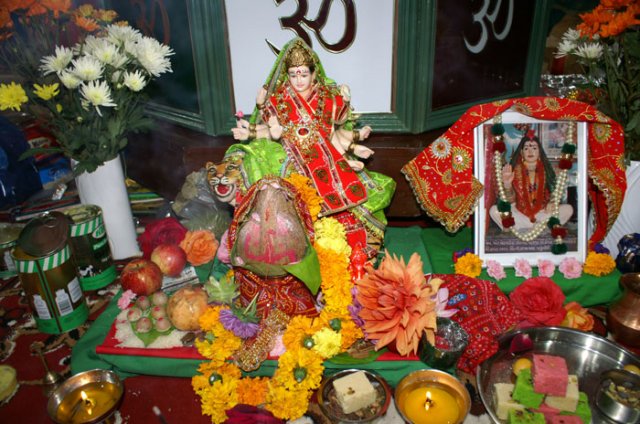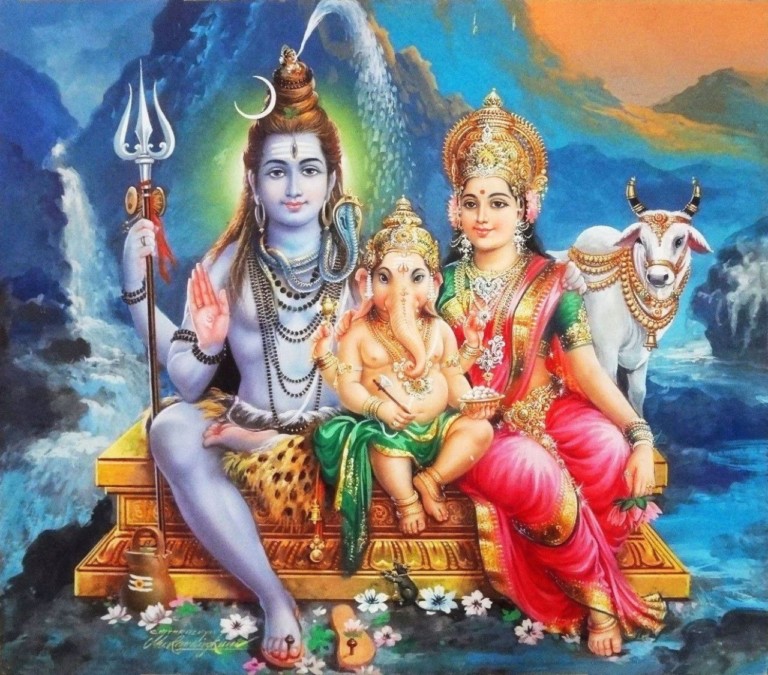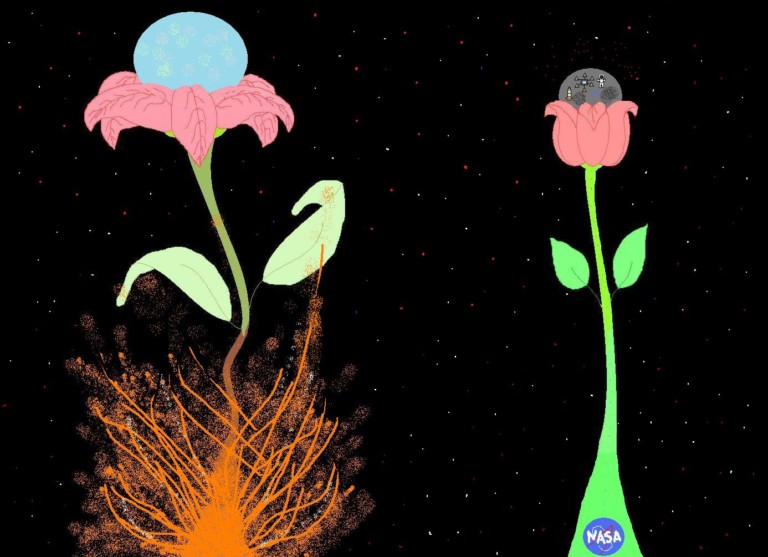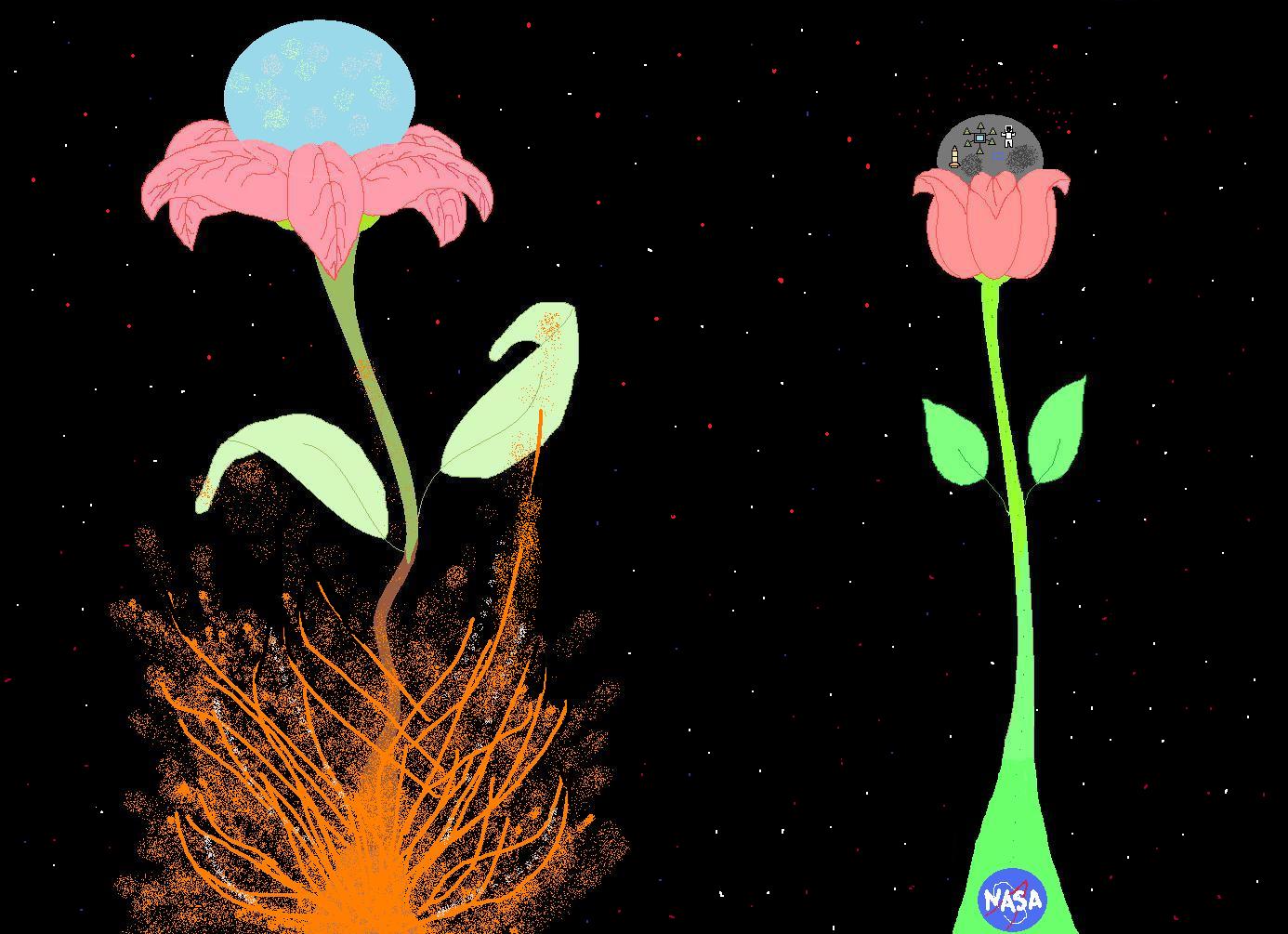Navratri 2010 Video Clips
Navratri Festival 2010 @ Maher Community Centre, Leicester, UK
Navratri Festival Day 3 – Sunday 10-10-10
http://www.youtube.com/watch?v=37kcOyBQPtU
Navratri Festival Day 3 – Sunday 10-10-10
http://www.youtube.com/watch?v=G06Ah6MlVvA
Navratri Festival Day 3 – Sunday 10-10-10
http://www.youtube.com/watch?v=2n8shzNa1Ck
more video clips coming soon…
View Photo Gallery
{phocagallery view=category|categoryid=119|limitstart=1|limitcount=10|detail=3|displayname=0|displaydetail=0|imageshadow=shadow1}
Santoshi Mata
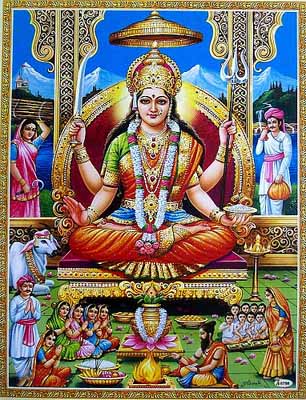 Santoshi Mataji Santoshi Mataji |
Santoshi Mata Pooja is usually performed for a period of 16 Weeks on Friday.
You will be required to have a Santoshi Matt Photo, the Pooja book which contains the story and for prasad you will need roasted chana, jaggery and green banana.
“You are not supposed to eat or touch anything which is sour like Curd, Lemon Etc”
On a Friday morning have head bath and place the photo in a clean Pooja area and put a small Kalash. Place Santhoshimatha’s photo and decorate it with flowers. Keep channa (soaked in water for 6 hours in water) or puffed bengal gram along with jaggery piece and bananas as prasadam. Light diya before the Goddess. Chant the mantras and read the story and give aarti to the Goddess and have prasadam. You can do fasting the entire day or can have food only once in a day (may be supper or dinner). You are not supposed to eat anything sour on the day of the Pooja…
You need to do this for 16 weeks on Friday, and after you finish the 16 weeks you will be required to do Udyapan, i.e. you will be required to offer food to kids and remember not to feed them anything sour and not to give them any cash, as they might use the cash to buy something sour.
First gather the things required and then start the Pooja.
Requirements for the Pooja:
- 1 kalash
- Betel leaves
- Flowers
- Dry whole channa and jaggery for prasad
- Camphor for aarti
- Agarbatti
- Diyas
- Turmeric
- Kumkum
- Photo of Santoshima
- Coconut for kalash (have to continue with the same coconut till you complete the Pooja)
- A wooden stool for placing the moorti
- Rice mixed with turmeric
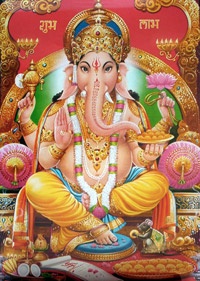
Shree Ganesh, father of Santoshi Mataji
|
Prayer to Santoshi mata’s father Ganesh, mother Riddhi Siddhi. Prayer to wealth, gold, silver, pearl, and other gems. Prayer to Ganapati to fulfill all our wishes. To have success in business, to remove poverty, destruction of evil. Let there be peace and happiness and light. Let there be a house full of children, profit in business and huge earnings, fulfillment of one’s desires destruction of evil, removal of sorrow and worry. The name of Santoshi mata gets all the work done smoothly.
Jai Santoshi Mata.
Shree Sidh Ganesh Vrat Katha
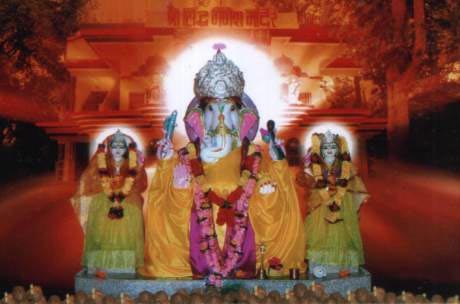
Shree Sidh Ganesh
|
Bhagwan Ved Vyas asked Brahmaji could you please explain what’s the benefit of Shree Sidh Ganesh Vrat and tell me who on Earth benefited from doing this vrat.
Then Brahmaji told this story. Oh my dear vyasji. Many people of Earth performed this vrat and by doing so they were blessed, from them I tell you a story of Surbahu Shatriya, now listern carefully.
There was a country city called Pipalpur in Goddesh country in the Southern hemisphere. There lived a honest but poor man called Surbahu. He worked very hard to feed this family but there was never enough for entire family. Seeing all this his wide Subhadra always complained and consistently nagged him about the poor situation they were in.
One day he had enough of this constant nagging and humiliation from his wife, Surbahu decided to run away from home, while the family was sleeping.
He ended up in the forest, thirsty, hungry and lost, started wondering around. In the end he ended up near a lake, walking to the lake he drank water and sat underneath a wonderful rubber (valdo) tree. While leaning against the tree he stated thinking about his many subjects in his head. While doing so he fell asleep. Many hours pasted while asleep, he had a dream that something was about to eat him, he thought it might be an animal but was too afraid to open his eyes and look. He assumed he was going to die so he prepared him self to face the death, thinking it’s better to die than to live such sad life. But suddenly something happened Surbahu slowly opened his eyes and saw a human figure in the night shadow. Seeing this he got up and shouted, why do you want to wake a poor guy like me in the middle of the night. Who are you and what do you want from me? Who ever you are just eat me and put me out of my misery from this life.
Hey dear, you seem depressed by this human life, but afraid not, my name is Kaushik Rishi (sage), I’ve been doing meditation in this forest for many years. Dear get up and come with me.
By saying comforting words Kaushik Rishi, helped Surbahu onto his feet and took him to his ashram and gave him food and drink and listened to his story. Kaushik Rishi was sadden by Surbahu’s poor condition.Kaushik Rishi blessed Surbahu and told him Shree Sidh Ganesh Vrat Katha and instructions about performing ritual everyday.
Surbahu stayed in Kaushik Rishi’s ashram and performed vrat as instructed.
During this period, Bhagvan Shree Sidh Ganesh blessed him. Back in his home kindom, Pipalpur, the king accepted Surbahu’s wife as his religious sister and provided them with necessary for confortable life. The king also send out his people in search of Surbahu.
After three months, Surbahu returned to Pipalpur on Bhadarva Sud Satudasiye after completing Bhagvan Shree Sidh Ganesh’s vrat. Seeing him, his wife and children were over joyed with happiness.
Subhadra told his husband, Surbahu the full story about king accepting her his religious sister and providing all care. Hearing all this Surbahu said “All this is due to blessing of Shree Sidh Ganesh”. Subhadra you should start performing this ritual everyday also. She performed vrat accordingly and with complete honestly and faith.
The king made Surbahu his comandar. Accepting all this as a blessing of Shree Sidh Ganeshji, he started living life with happiness.
His Surbahu became a king named Naal, in his next life.
Jai Shree Sidh Ganesh Namah
Vrat
Vrat denotes a religious practice to carry out certain obligations with a view to achieve divine blessing for fulfillment of one or more than one desire. Etymologically, vrat, a Sanskrit word (and also used in several Indo-European languages), means to vow or to promise.
A vrat may consist of one or more of several actions. Such actions may include complete or partial fasting on certain specific days; a pilgrimage (thirtha) to a particular place or more than one place; a visit and darshan and puja at a particular temple or more than one temple; recitation of mantras and prayers; performing puja and havans.
According to Hindu scriptures, vrat assists the person doing the vrat to achieve and fulfill his desires as performing vratas are supposed to bring the divine grace and blessing. Sometimes, close relatives or family purohits may be entrusted with the obligation of performing the vrat on behalf of another person. The object of performing vrat is as varied as the human desire, and may include gaining back lost health and wealth, begetting offspring, divine help and assistance during difficult period in one’s life. In Ancient India, vrat played a significant role in the life of individuals, and it continues to be practiced in modern times as well by a number of Hindus.
Calling all females in London to join our first ever London Maher Netball team
 |
We are a small group of girls who have recently started training and are looking for more ladies to join us.Training is held on sunday mornings and thursday evenings in the borough of Hounslow and the minimum age is 14.
If you are interested in joining London Ladies Netball Team for competitive or fitness purposes please contact Daxa on 07947 681 853
Jaya Parvati Vrat

Jaya Parvati Vrat is a fasting ritual. It is observed for 5 days. It is then celebrated by an all night Jagaran or keeping awake. Unmarried girls perform this fast and worship Parvati to have good husbands in marriage. This is called Jaya Parvati Vrat because Parvati performed fasts to win Shiva as her husband. Young girls take this up in the ninth month of Ashada, around July-August. Click here to view this year’s dates
There is a legend behind Jaya Parvati Vrat. There was a Brahmin couple and both were devotees of Lord Shiva. They had everything in their life except for a child. They used to worship Lord Shiva every day in the temple. Lord Shiva was pleased with the devotion of the couple and there was a revelation. It said, “My Shiva Linga is at a certain place in the jungle. Nobody is performing its puja. Your wishes will be fulfilled if you go there and perform its puja.”
The Brahmin couple went to the jungle and found the place where Shiva Linga was. The husband went in search for flowers for use in the puja. However, a snake bit him on the way and he fell on the road in an unconscious state. His wife was very worried. She prayed for her husband’s safety for several days. Lord Shiva saw the true devotion of this Brahmin woman and brought her husband back to consciousness. The couple continued to pray at the Shiva Linga. They were blessed with a son.
This was how Jaya Parvati Vrat originated. During Jaya Parvati Vrat, you cannot eat any foods with salt. No wheat products or vegetables are allowed either. Women perform this vrat for 5 or 7 years. Then, they celebrate it by inviting other women to their homes for a meal. It is believed that Jaya Parvati Vrat brings happiness to a family and a good husband for the girl doing the fast.
On the first day of the vrat, Javera (wheat seeds) are planted in a small bowl / pot and kept by the mandir in the house. Puja is then conducted with the javera pot and a “nagla” – a necklace of cotton wool decorated with kanku spots – which is placed around the edge of the pot to surround the javera. Every morning, after you have bathed, the same ritual is carried out and the javera is watered. The javera seeds will sprout and grow over the 5 days of the vrat.
A full puja is done at a mataji temple on the final day to break the fast and a full meal with salt and wheat can then be eaten. On the 6th day, after bathing, the javera are taken from the pot and planted in the garden.

|| Shiv Arti ||
OM JAI SHIV OMKARA, PRABHU JAI SHIV OMKARA
BRAHMA VISHNU SADA SHIV, ARDHANGII DHARA
OM JAI SHIV OMKARA…
EKANANA CHATURANAN PANCHANAN RAJE
HANSANAN, GARURAASAN VRISHVAHAN SAJE
OM JAI SHIV OMKARA….
DO BHUJA, CHAAR CHATURBHUJA DASHABHUJA ATI SOHE
TIINON ROOP NIRAKHATE TRIBHUVAN JAN MOHE
OM JAI SHIV OMKARA…
AKSAMALA VANAMALA MUNDAMALA DHARI
CHANDANA MRIGAMAD SOHAI BHAALE SHASHIDHAARI
JAI SHIV OMKARA…
SHVETAMBARA PIITAMBARA BAAGHAMBARA ANGE
BRAHMADHIK SANAKAADHIK PRETAADHIK SANGE
OM JAI SHIV OMKARA…
KARA MADHYE KAMANDALU AU TRISHUL DHARI
JAGKARTA JAGHARTA JAGAPALAN KARTA
JAI SHIV OMKARA…
BRAHMA VISHNU SADASHIVA JANATA AVIVEKA
PRANAVAKSAR KE MADHAYA TINONH EKA
OM JAI SHIV OMKARA…
TRIGUN SWAMI KI AARTI JO KOI NAR GAVE
KAHATA SHIVANANDA SWAMI MANA VANCHITA PHALA PAVE
JAI SHIV OMKARA…
Snehal Odedra take part in NASA Art Contest
NASA – has featured Snehal Odedra’s art on their website.
Snehal Odedra took part in NASA Art Contest and she was one of many students that took part in this project for NASA named “Work on the Moon.”
She was the only one INDIAN who took part in this project in Master student category and her project is selected by NASA for their Online gallery.
Welldone to Snehal for making her family and the entire Maher Community proud.
Description
This image shows that NASA work hard and “THINK OUT OF BOX” for devlope NEW WORLD for people and people can also help for developing new world.In image we can see Astronut,Settlement for people,Sapce shuttle of NASA. Main thing we see that Our Earth going to Finish than Noone can save people but NASA can do this Miracle by devloping New Earth on the Moon.so 1st burning flower is of EARTH and New flower of Moon which growing is for Moon,on which NASA devlope “NEW WORLD”. 🙂
Artist Statement
Respected Sir/Madam, Its my pleasure to taking part into this contest which organized for making New World on the MOON.From the title of this contest i designed my art.In my art we can see that Life on Earth is produced by GOD while on Moon life will produced only by NASA.So,that’s why the title of my art is ‘UDAYAN’ – The Rising Sun. Thank you, Snehal Odedra

